A guide
Contact center transformation
Interested in transitioning from an on-prem contact center setup to a cloud-based operation? Learn how to do this below. Or, book a product tour to see how your organization can do this with Dialpad's AI-powered customer engagement platform!

Today, fewer and fewer companies have large in-office call center teams. A busy contact center is more likely to have a mix of both work-from-home agents and in-office agents instead of hundreds of agents all in one room.
And a big reason for that is because many businesses have undergone contact center transformations. Not only is it an incredibly important part of overall enterprise digital transformation, it also comes with other benefits like cost savings and more flexibility in global hiring.
In this guide, we’ll explore the essentials of contact center transformation including what it is, what you’ll need to make it happen, and how to make your agents and supervisors as successful as possible during and after this shift.
But first, let’s look at what exactly contact center transformation is.
What is contact center transformation?
Contact center transformation is the process of modernizing a business’ outbound sales and/or inbound customer service systems and processes. This is most often done by adopting digital communication channels and new technologies like customer service AI (or sales AI) tools, automation, and cloud-based solutions.
Different contact center teams, of course, will have specific strategies or tasks in mind. Some leaders may want to consolidate disparate systems into one unified platform, while others prioritize creating AI-powered self-service options for customers.
Overall though, most businesses’ contact center transformation goals are to improve customer satisfaction, gain more insights into performance, reduce operational costs, and ultimately, increase revenue.
How can digital transformation improve a contact center?
Digital transformation is revolutionizing how contact centers operate and manage customer interactions. Here are a few key ways it can improve both efficiency and effectiveness:
It allows businesses to provide an omnichannel experience
One way digital transformation affects contact centers is by giving customers more channels to interact with a business. This includes options like social media, live chat, chatbots, and email in addition to voice calls.
Old school on-premises call center platforms don’t typically allow for all these communication channels, and the need to support these channels is a common catalyst for contact center transformation.
🔎 Case study:
See how Tecovas’ customer support team manages customer calls and support tickets from a single platform with Dialpad, which integrates with their CRM, Kustomer.
It reduces the burden on supervisors
Contact center supervisors are often overwhelmed with the amount of work they have to manage, from training new agents to monitoring call quality in real time.
With contact center transformation, supervisors can take advantage of automation tools and AI-driven customer engagement platforms to reduce their workload and free up more time for other tasks.
For example, Dialpad’s AI-powered contact center solution can automatically detect positive and negative sentiment of customer conversations in real-time and alert supervisors when necessary:
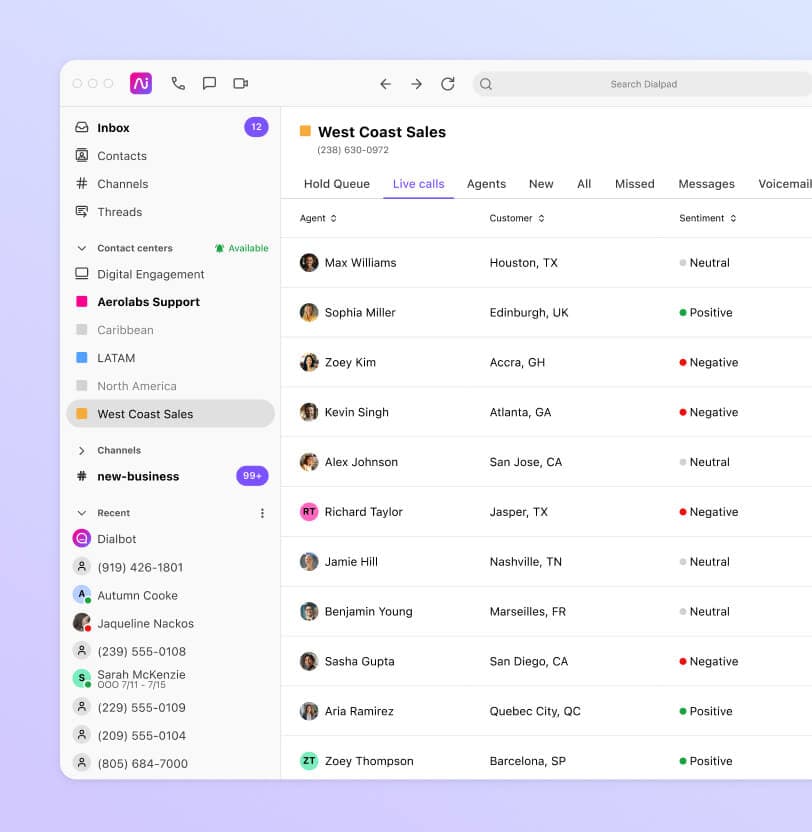
If a supervisor is overseeing tens or hundreds of agents on simultaneous calls, this helps them quickly and easily spot if an agent needs help. If they do, they can just open up the real-time transcript to get more context before deciding whether they need to barge the call.
On top of that, contact center transformation also helps supervisors keep an eye on their KPIs. With traditional on-prem systems, accessing analytics tended to be time-consuming and complex—especially if your provider took a long time to get back to requests for data. (Learn more about on-prem vs cloud.)
Today, some cloud contact center solutions come with built-in analytics dashboards that give supervisors insights into agent performance—in real-time—along with a better understanding of how their operations are running at any given time. This allows them to make informed decisions quickly, adjust their strategies accordingly, and maintain high customer service levels.
For example, one of the biggest challenges with collecting CSAT scores is that not a lot of people actually fill out these surveys.
In fact (depending on the industry and specific business of course), we've found that on average only about 5% of customers actually fill out CSAT surveys. On a related note, usually only the angriest—and happiest—customers actually bother to respond to these surveys, which means your CSAT answers are likely to be very skewed and not representative of how your customers feel overall.
Dialpad's industry-first AI CSAT feature can infer CSAT scores for 100% of customer calls, which results in a much more representative sample size for CSAT scores, and a more accurate understanding of how satisfied customers really are:
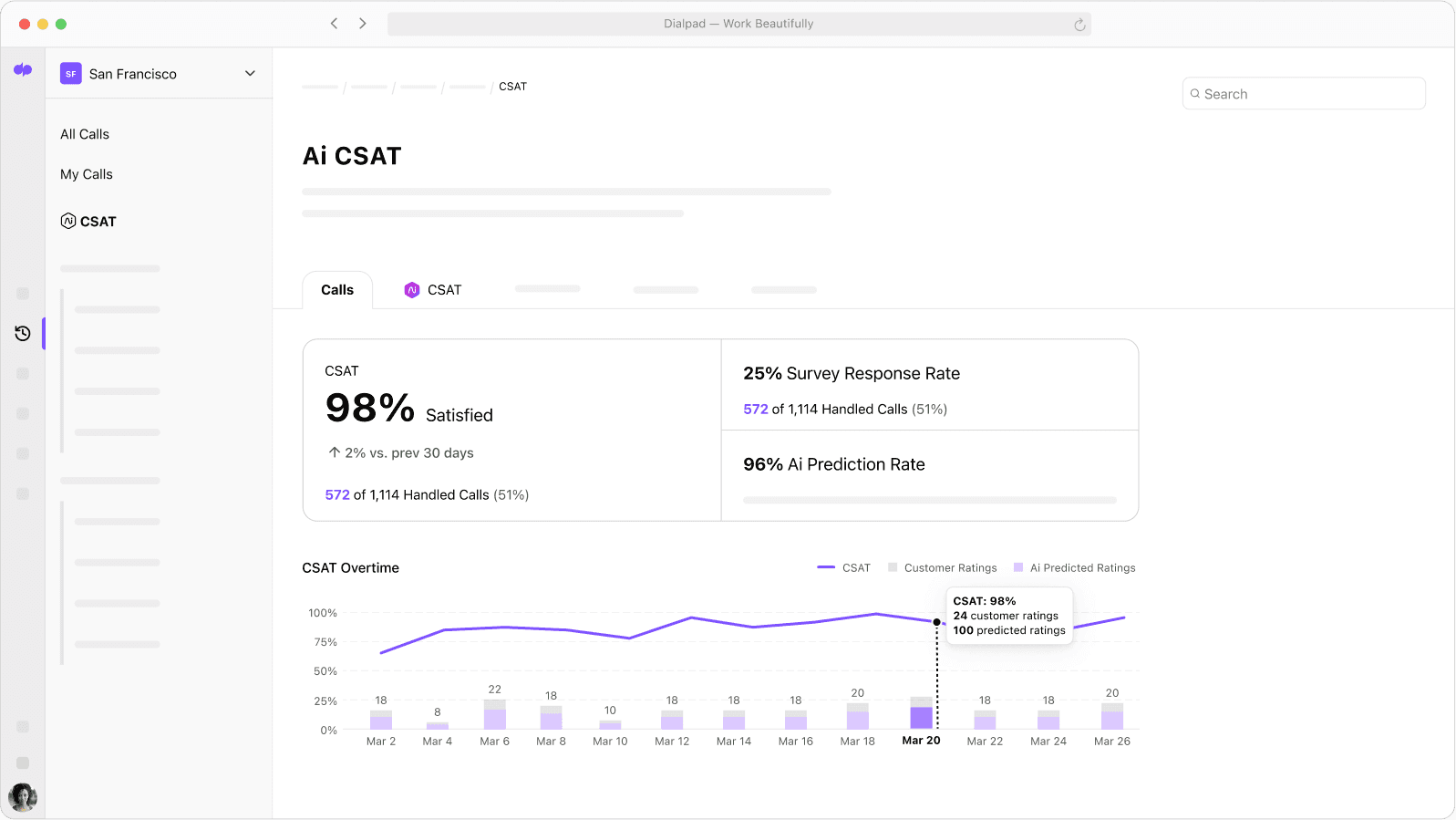
This is just one example of how contact center transformation can provide unprecedented insights for supervisors and business leaders compared with on-prem systems.
It frees up human agents to speak to customers
Another way digital transformation impacts contact centers is by providing automation options that streamline tasks like data collection and note-taking.
A large piece of this is thanks to modern AI call center features. For example, agents tend to spend a lot of time on after-call work like summarizing and dispositioning the conversation.
With some modern contact center solutions, there are features like AI-suggested dispositions and note-taking, which automatically do this work for agents.
Not only that, conversational AI (essentially very advanced chatbots) can answer a variety of customer inquiries, which reduces call volumes for overwhelmed agents. This is a great example of how automation doesn’t replace agents—it amplifies their capacity and allows them to focus on interactions that matter most.
It enables round-the-clock support with distributed teams
Cloud-based contact center technologies have also made it possible for businesses to expand their geographic reach—without needing physical space or additional IT resources.
Unlike traditional setups that required agents to be in a physical location, modern platforms allow businesses to hire talent from anywhere in the world. This means customer support can be available 24/7, without requiring late-night shifts or costly overtime.
It also gives businesses the flexibility to scale their teams more easily during seasonal peaks or product launches—without the limitations of physical infrastructure.
Automation plays a key role in scaling this model, with virtual agents and AI-powered self-service options able to triage support requests, answer FAQs, and even complete simple transactions—all without human intervention. Whether it's answering FAQs, processing transactions, or triaging support tickets, AI helps maintain continuous service coverage and ensures customers get timely responses—even when live agents aren't online.
It improves brand reputation and customer loyalty
Contact center transformation doesn’t just improve efficiency either—it also delivers better customer experiences, which directly supports brand reputation.
When customer inquiries are resolved faster, more accurately, and in a more personalized way, customers walk away feeling heard and valued. And when those experiences are consistently positive across all touchpoints—phone, chat, email, and more—it builds trust and long-term loyalty.
Investing in tools that streamline operations and provide personalized service doesn't just benefit internal workflows; it shows customers that the brand is modern, responsive, and customer-first.
It turns the contact center into an insights engine
Modern contact centers generate a wealth of data—from call recordings to real-time transcriptions and AI-driven analytics. With the right tools, this data can be mined for powerful business insights.
For example, if many customers start calling in about a specific issue, that pattern can be identified quickly and resolved at the root—before it escalates.
Or if customers repeatedly ask about a particular product feature, that feedback can be looped into product development discussions.
Dialpad Support, for instance, uses AI to track topic trends across customer conversations and surface insights that help teams—from support to product to marketing—make smarter, faster decisions. This turns the contact center from a reactive support hub into a proactive strategic asset.
Technology for contact center digital transformation
Digital transformation in contact centers might sound complex—or even intimidating—but it’s far more achievable than many people realize. While concepts like AI, automation, and omnichannel support can feel overwhelming at first, the reality is that today’s technology is designed to be more accessible, flexible, and user-friendly than ever before.
In fact, many businesses have already taken small steps toward transformation without even realizing it—whether by using chat support, integrating with CRMs, or adopting cloud-based tools. You don’t need to overhaul everything at once. The right tools can help you modernize your contact center incrementally, with clear, tangible benefits at every stage.
Here are a few specific types of technology that make this transformation possible—and manageable.
A CCaaS solution (cloud-based)
An essential piece of technology for contact centers interested in digitizing operations is a CCaaS (Contact Center as a Service) solution. Similar to UCaaS, or Unified Communications as a Service, solutions, CCaaS products are paid for on a subscription-based model—usually monthly or annually.
These are both modern alternatives to legacy on-premises communications solutions, which require hardware, wiring, and significant initial investment. With CCaaS and UCaaS solutions, businesses only need to provide their employees with computers, and they’ll be able to work from anywhere using the solutions’ desktop and/or mobile apps.
For contact centers specifically, a CCaaS or cloud contact center solution will let agents and supervisors manage all their internal and external communications from a single app. This includes voice calls (over the internet, through VoIP or Voice over Internet Protocol technology), team and SMS/MMS messaging, video conferencing, live chat messages, social media conversations, and so on.
CRM and other integrations
A cloud CRM solution is crucial for any contact center team undergoing digital transformation, because it gives agents and supervisors a centralized database of all customer relationship information.
From past customer conversation records to sales pipeline tracking, a CRM makes it possible for both support and sales agents to easily access information that’ll help them have more successful customer interactions, no matter what channels they’re on.
The CRM your team uses should integrate with your contact center solution—this will automatically sync calls, messages, and activity logs to the right contact records, reducing manual work for agents. It also enables them to make or receive calls directly within the CRM interface, without needing to switch back and forth between different apps. This saves time and improves accuracy.
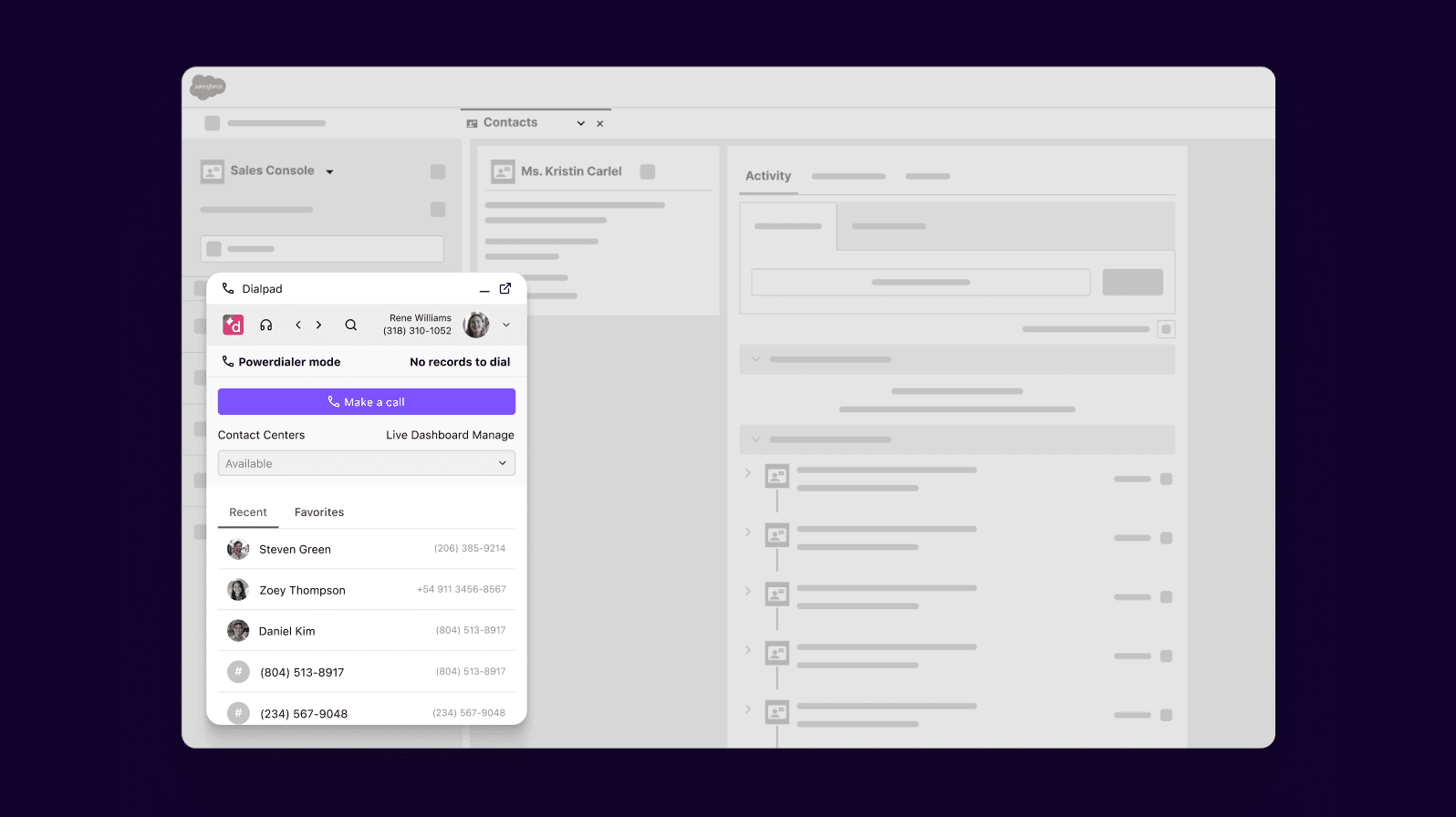
Beyond CRMs, other types of cloud-based software can also play a key role in digital transformation. Integrations with helpdesk platforms (like Zendesk), industry-specific tools, and even team collaboration apps (like Google Workspace or Microsoft Teams) help streamline day-to-day workflows.
These integrations reduce data silos and create a more connected tech stack—ensuring that agents have the right context, tools, and information at their fingertips in real time. Whether it’s surfacing knowledge base articles during a live call or automatically logging a support ticket after a conversation, these integrations help improve both the agent experience and the customer experience.
Omnichannel functionality
True omnichannel functionality is one of the biggest opportunities—and challenges—of contact center transformation. Many businesses set out to offer support across multiple channels, but quickly realize that managing them in silos creates more problems than it solves.
The goal of omnichannel contact center transformation isn’t just to “be everywhere”—it’s to unify the customer experience across every touchpoint. Whether a customer starts a conversation in live chat, follows up over email, and then calls in, your agents should be able to see the full context of those interactions in one place.
That’s where digital transformation makes a real difference. With the right contact center platform, all these communication channels—voice, SMS, live chat, social media, email, and more—can be routed through a single system. This gives agents a comprehensive view of every customer interaction, so they don’t have to ask repeat questions or dig through multiple tools to get the full story:
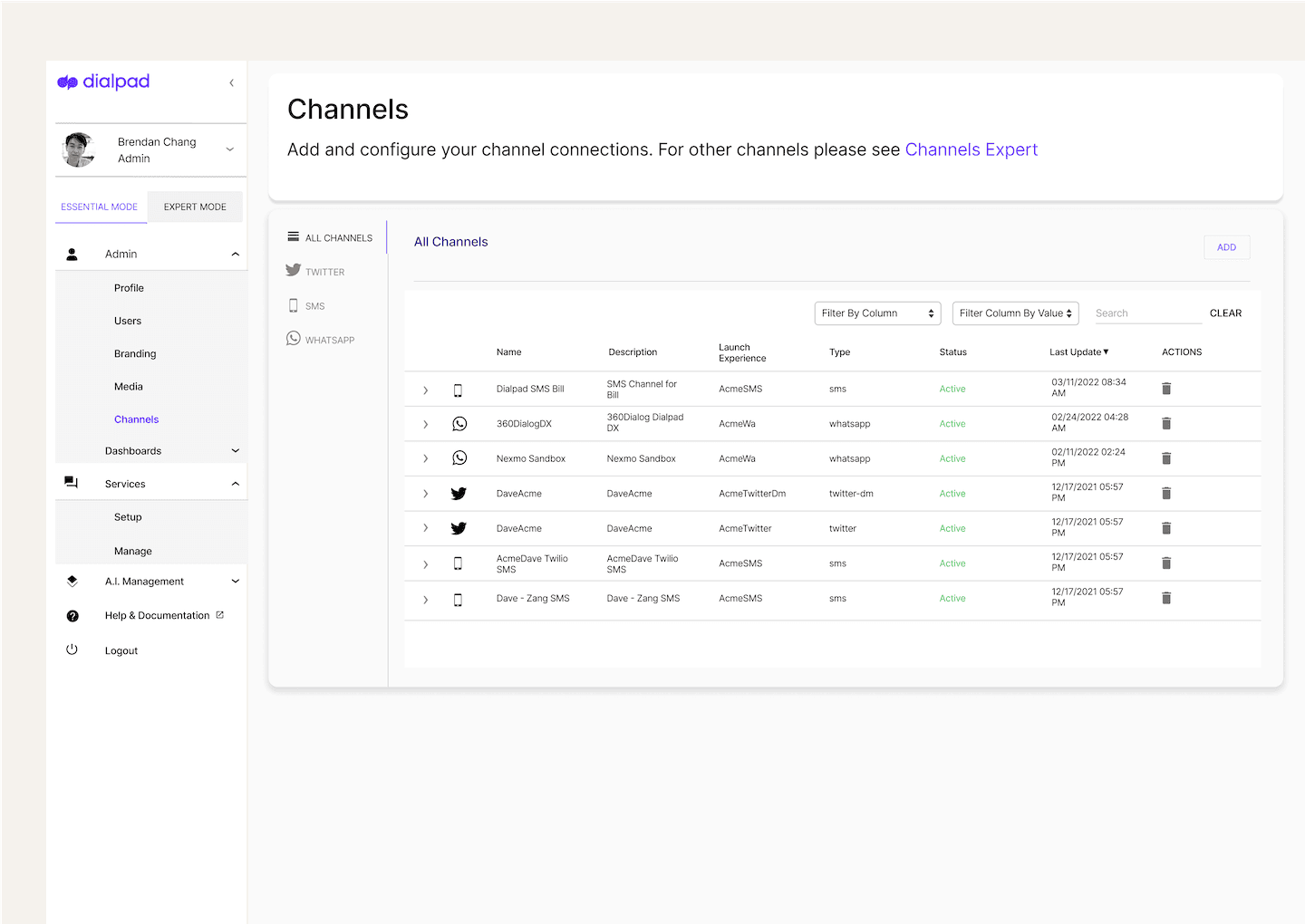
And from the customer’s perspective, it means seamless, frustration-free support. They don’t have to explain their issue all over again every time they switch channels or get handed off to a new agent.
While it may have felt complex in the past, today’s tools make omnichannel support much more manageable—even for lean teams. With built-in routing logic, unified inboxes, and integrations with your CRM and other systems, you can meet customers where they are without sacrificing efficiency behind the scenes.
Artificial intelligence (AI)
AI-powered customer engagement tools allow contact center teams to automate many of the repetitive, time-consuming tasks that bog down both agents and supervisors. From data entry and after-call summaries to appointment scheduling, QA scoring, and reporting, AI helps teams work more efficiently while delivering faster, smarter service to customers.
But beyond just handling routine tasks, AI is becoming a powerful co-pilot in real-time customer interactions. For example, Dialpad AI can surface live coaching tips to agents during calls, detect customer sentiment in the moment, and flag conversations that may require supervisor attention:
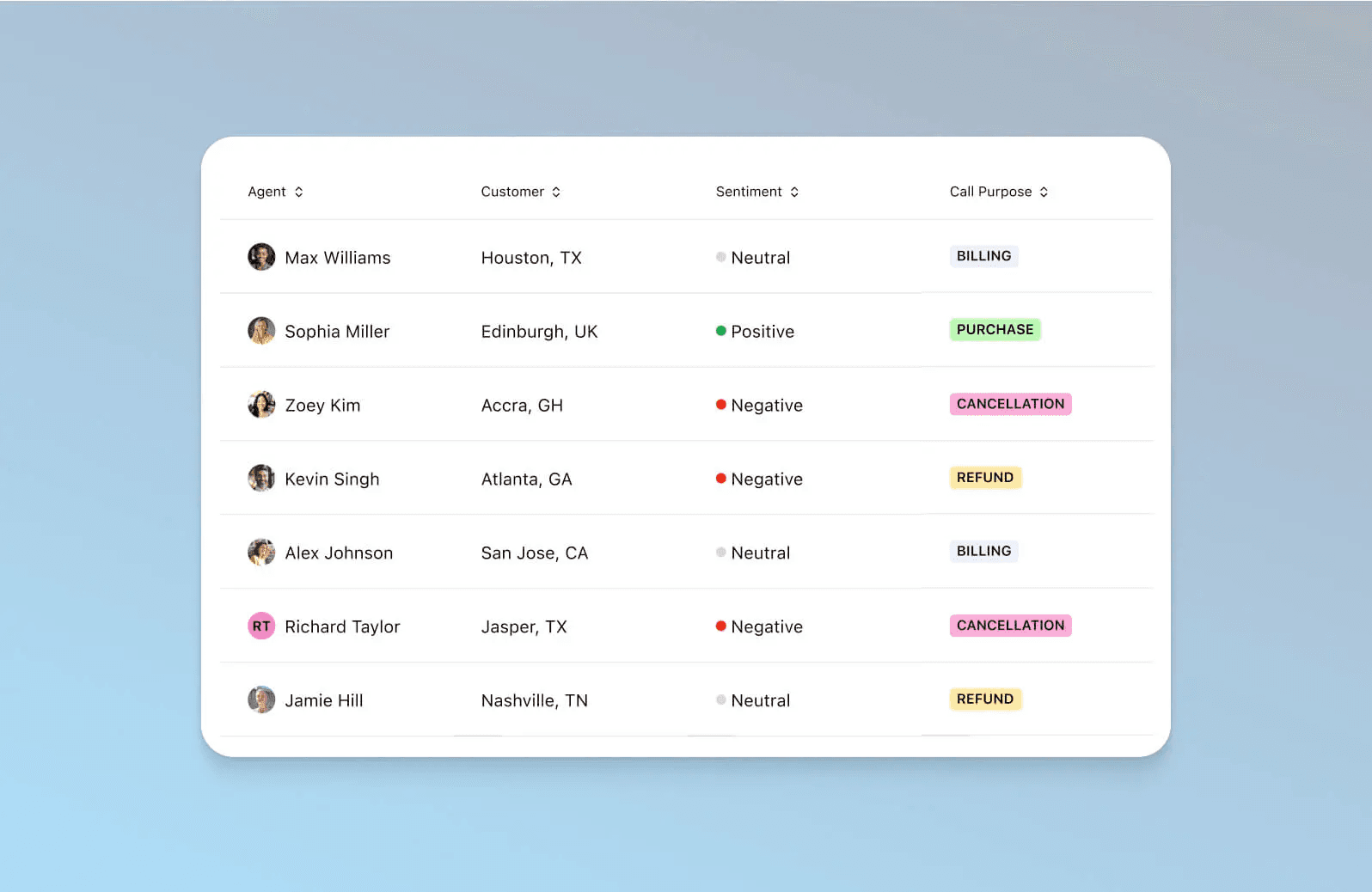
This kind of real-time assistance improves call outcomes and empowers agents to perform better, especially in high-pressure situations.
Supervisors also benefit from contact center AI tools that help them stay on top of trends and spot issues early. With Dialpad Support, for example, you can set up “Custom Moments” to track how often specific keywords or topics come up in customer conversations. Want to know how many customers have been asking about refunds? Just set up a Custom Moment to detect phrases like “refund” or “money back,” and get notified automatically when those topics spike:
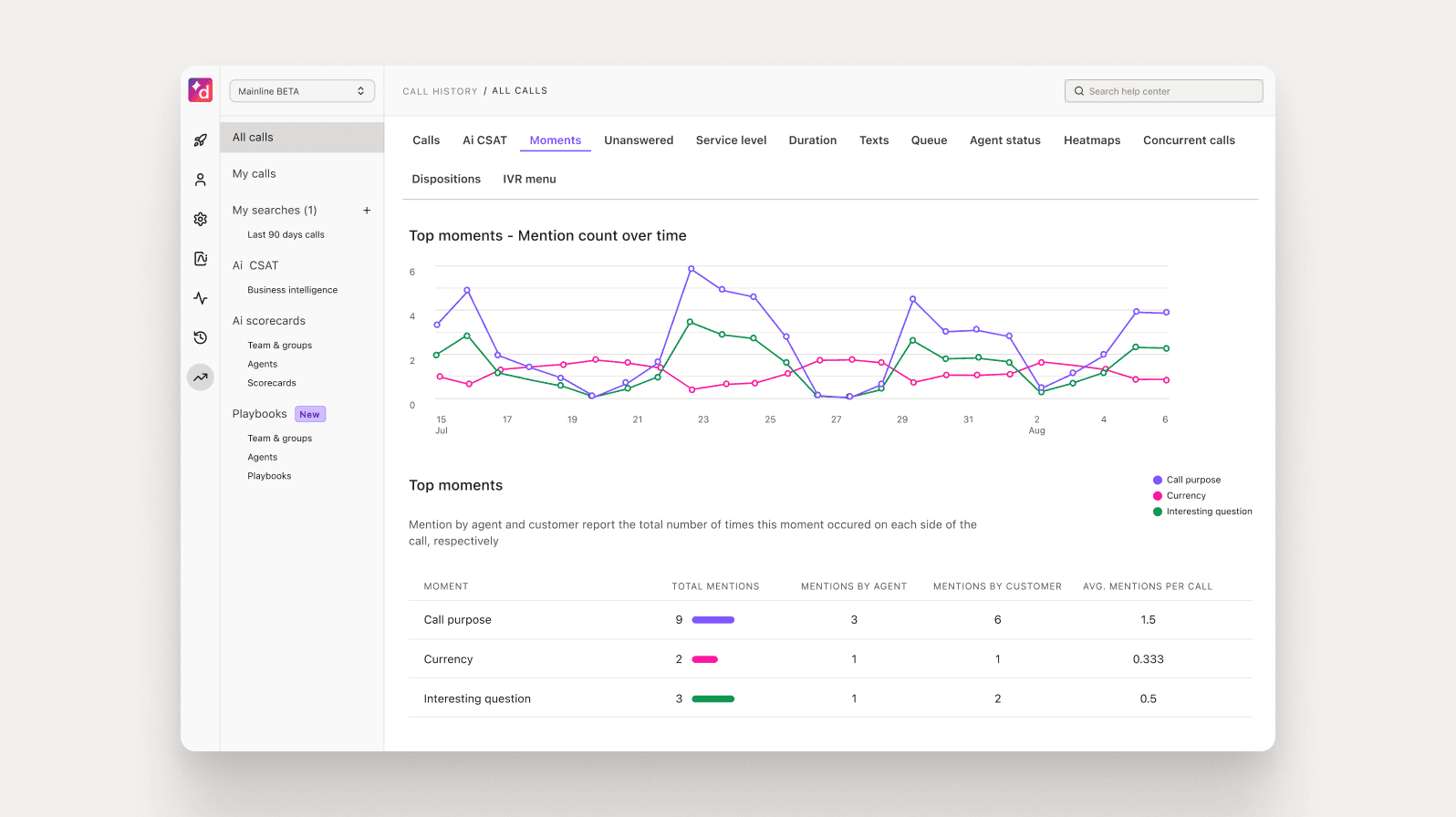
This gives contact centers a continuous pulse on customer sentiment and emerging issues—without having to manually listen to dozens of calls.
Looking ahead, we’re entering a new era of agentic AI—where AI doesn’t just assist with tasks, but can proactively take action on behalf of agents and supervisors. Imagine an AI that not only summarizes a call, but also drafts a follow-up email and schedules a task in your CRM. Or one that spots a pattern in customer complaints, correlates it with a recent product update, and automatically alerts the right internal team.
These next-generation capabilities are already beginning to take shape, and they’re making the vision of an intelligent, adaptive, and self-optimizing contact center a reality. The best part? These tools are being designed to integrate seamlessly with your existing systems and workflows, so they enhance—not disrupt—your team’s day-to-day operations.
Digital transformation roadmap
Many teams struggle to know where to begin or how to prioritize their efforts. That’s why having a clear digital transformation roadmap is so valuable—it helps you break the process into manageable, strategic steps.
At a high level, a contact center transformation roadmap outlines:
Where you are now (e.g. on-prem vs. cloud, limited automation, siloed systems)
Where you want to go (e.g. unified, omnichannel, AI-powered contact center)
The steps to get there (e.g. migrating to CCaaS, integrating your CRM, enabling AI agents or other real-time assist tools)
You don’t have to do everything at once. In fact, many teams find success by starting small—like automating after-call summaries or rolling out live chat—and building from there.
📖 Further reading: Check out this blog on building a digital transformation roadmap for tips, examples, and a step-by-step breakdown to help you plan and implement your next move.
Transform your contact center with Dialpad
If you’re thinking ahead and planning to digitize your contact center operations, the first step is to equip your team with the tools they’ll need to go through the transition smoothly.
A robust contact center or customer engagement platform with AI-powered customer experience features built right in, along with a CRM software, are two essential components of the digital transformation roadmap.
See how other contact centers have moved to the cloud with Dialpad!
Get started with contact center transformation today
Book a demo of Dialpad's AI-powered contact center platform with our team, or take a self-guided interactive tour of the app on your own first!
